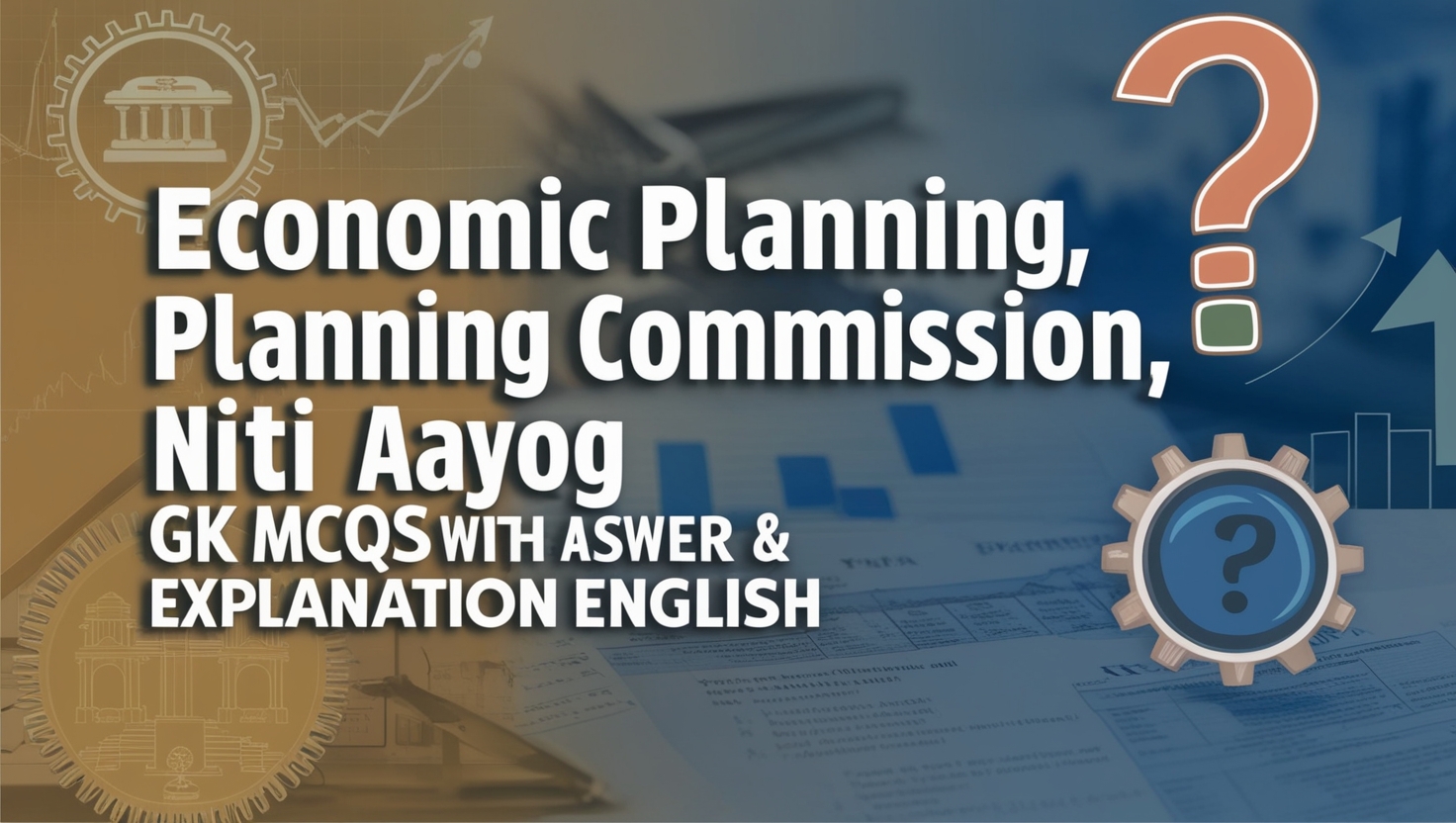
Economic planning has played a crucial role in shaping India’s economic policies and development trajectory over the decades. This article, titled Economic Planning, Planning Commission, NITI Aayog GK MCQs With Answer & Explanation in English, offers a collection of multiple-choice questions designed to test and expand your understanding of the evolution of economic planning in India.
From the foundational work of the Planning Commission to the forward-thinking initiatives of NITI Aayog, these MCQs include detailed answers and explanations to deepen your knowledge. Whether you’re a student, exam aspirant, or economics enthusiast, dive in to explore and learn!
1. In which year was the first five-year plan launched in India?
- 1950
- 1951
- 1952
- 1953
Show Answer
Answer: 1951
The first Five-Year Plan in India, launched in 1951, was primarily focused on the development of the primary sector, with an emphasis on agriculture and rural development. It was presented by India’s first Prime Minister, Jawaharlal Nehru.
2. In which year was the Planning Commission established in India?
- 1950
- 1951
- 1952
- 1955
Show Answer
Answer: 1950
The Planning Commission was established in March 1950 through a Cabinet Resolution of the Government of India. Jawaharlal Nehru served as the first Chairman of the Planning Commission, which was responsible for formulating long-term development strategies and assessing available resources.
3. How was the Planning Commission of India established?
- Act of Parliament
- Presidential Order
- Presidential Ordinance
- Cabinet Resolution
Show Answer
Answer: Cabinet Resolution
The Planning Commission was set up by a Government of India Resolution in 1950 as an advisory and specialised institution. It was charged with the responsibility to formulate a strategy of development for independent India in a long-term perspective and for making an assessment of all resources of the country, augmenting deficient resources, formulating plans for the most effective and balanced utilisation of resources, and determining priorities.
4. What was the period of India’s First Five Year Plan?
- 1951-56
- 1961-66
- 1969-1974
- 1979-1984
Show Answer
Answer: 1951-56
India’s First Five-year Plan was implemented from the year 1951 till 1956. It mainly focused on the development of the primary sector. The Plan was based on the Harrod-Domar model implemented with some modifications.
5. Which among the following is the main feature of Democratic planning?
- Inducement
- Government
- Direction
- Flexibility
Show Answer
Answer: Flexibility
Democratic planning is a participatory planning process that involves the participation of all citizens in an economy, either directly or indirectly. It is commonly adopted in mixed economies.
6. In which of the five-year plans in India, the concept of Financial Inclusion was included for the first time?
- 8th Five Year Plan
- 9th Five Year Plan
- 10th Five Year Plan
- 11th Five Year Plan
Show Answer
Answer: 11th Five Year Plan
The 11th Five-Year Plan was implemented during the tenure of Prime Minister Manmohan Singh, with the slogan “Faster and more inclusive growth.” It focused on financial inclusion, poverty reduction, education, and skill development.
7. Who among the following was the first Deputy Chairman of the Planning Commission?
- V.T. Krishnamachari
- C.M. Trivedi
- Gulzari Lal Nanda
- Ashok Mehta
Show Answer
Answer: Gulzari Lal Nanda
Gulzari Lal Nanda was the first Deputy Chairman of the erstwhile Planning Commission. He later became the Prime Minister of India.
8. When was the Bombay Plan presented?
- 1934
- 1940
- 1942
- 1944
Show Answer
Answer: 1944
The Bombay Plan was presented in 1944 by eight industrialists of Bombay, including JRD Tata, GD Birla, Purshottamdas Thakurdas, Lala Shriram, Kasturbhai Lalbhai, AD Shroff, Ardeshir Dalal, and John Mathai. It outlined a plan of economic development for India, aiming to double the per capita income in 15 years and triple the national income during this period.
9. Which of the following Five Year Plans set the lowest growth target?
- 1st
- 2nd
- 3rd
- 4th
Show Answer
Answer: 1st
In the first Five-Year Plan, the target annual GDP growth rate was 2.1%, while the achieved growth rate was 3.6%. Targets in subsequent plans were set with respect to National Income, Net Domestic Product, or Gross Domestic Product at factor cost.
10. The targets from the fifth five-year plan were set with respect to which of the following parameters?
- National Income
- Net Domestic Product
- Gross Domestic Product at Factor Cost
- Gross Domestic Product at Market Cost
Show Answer
Answer: Gross Domestic Product at Factor Cost
Targets for the first three plans were set with respect to National Income. In the fourth plan, it was Net Domestic Product. In all plans thereafter, it has been Gross Domestic Product at factor cost.







